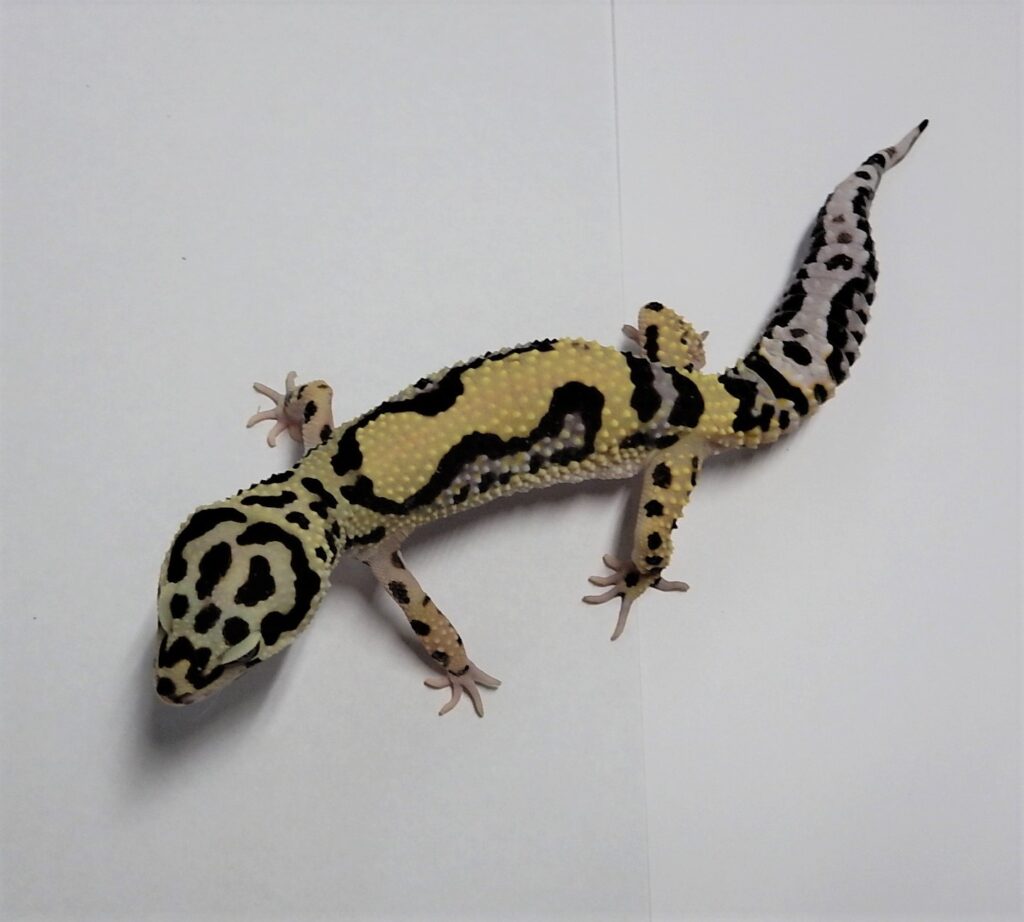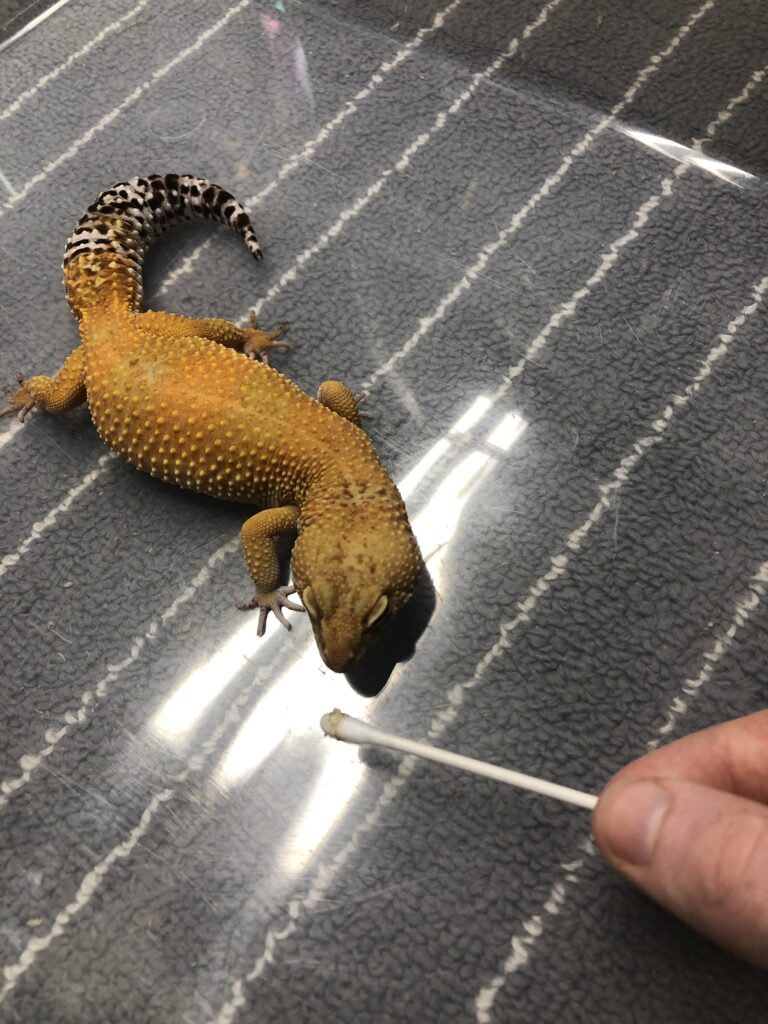I have been keeping Eublepharis macularius for eight years and one of the most enjoyable parts of maintaining them is watching them hunt. The questions beg to be asked: “Can E. macularius discriminate between prey items? And if so, how?” A series of different substances will be presented to some of my E. macularius to answer the first question. For the second question, olfaction and vomerolfaction will be looked at. Olfaction is the ability to determine odors by the olfactory system once they enter the nasal cavity, (essentially the sense of smell).’1 Vomerolfaction is the ability to determine chemical samples in the vomeronasal system (through tongue-flick in this case).’2 There is no visual-cue for the olfactory process but tongue-flicking can indicate the process of volemerolfaction. I wanted to explore the chemical-discrimination abilities in my E. macularis, as well as how they do it.
The base of the experiment was inspired by a similar experiment performed by William E. Cooper Jr. in 1998. His experiment used Coleonyx variegatus, a Eublepharid like E. macularius.‘3 The structure of the experiment is similar, although my procedure for data collection differs slightly to fit my vision for my specific experiment. I imagine our respective experimental goals were similar, I just had a different idea of how to achieve it.
13 sexually mature (over one year of age) E. macularius participated in this experiment. The geckos were presented with three different substances on a q-tip (each substance was presented a week after the next). Each trial was performed on a Monday. My adult E. macularis are cleaned and fed on Saturdays and Tuesdays, so performing the trials on Mondays would cause them to be more concerned with potential prey, as they would not be full. Tenebrio molitor (mealworm) matter (prey substance) was presented the first week on September 20th, 2021. Then, water was presented the second week as a standard on September 27th, 2021. A 1:4 ratio of natural dish soap to water was presented for the third trial during the last week of the study to serve as another pungent control that was not prey on October 4th, 2021.

A q-tip with a substance would be presented approximately ½ of an inch away from a gecko’s snout. 30 seconds was given for the gecko to tongue-flick or bite the q-tip. If the gecko bit the q-tip without a tongue-flick, its tongue-flick count was recorded as 0 and not redone. If the gecko did not tongue-flick or bite in the 30 seconds, the trial was redone on Tuesday, before the gecko’s feeding and cage’s cleaning. If the gecko did not tongue-flick or bite again, its score was recorded as 0. If the gecko tongue-flicked, 60 seconds was given for the gecko to tongue-flick as much as it preferred, and data was not counted after the 60 seconds was over. Number of tongue-flicks was recorded as well as if the gecko bit the swab or not. If a gecko began to move, the q-tip was kept ½ of an inch in front of the gecko’s snout until the 30 seconds or 60 seconds were up.

Note: scene is not from experiment but a replica for example
Tongue flick response data:
For all participants (n=13)
| Mealworm | Water | Soap | |
| Mean | 10.5 | 5.8 | 6.5 |
| Range | 0-19 | 1-23 | 0-18 |
For participants that did not bite (n is different for each condition)
| Mealworm | Water | Soap | |
| Mean | 14.9 | 5.8 | 7.1 |
| Range | 9-19 | 1-23 | 3-18 |
For participants that bit (n is different for each condition)
| Mealworm | Water | Soap | |
| Mean | 4.8 | N/A | 0 |
| Range | 0-12 | N/A | 0 |
Bite response data to respective conditions:
| Mealworm | Water | Soap | |
| Number of bite responses | 6 | 0 | 1 |
From the data, it can be determined that E. macularius can discriminate amongst chemicals. The average number of tongue-flicks in response to the mealworm stimuli was significantly higher in comparison to those in response to the water control and pungent soap solution. The geckos were much more interested in the mealworm stimuli, indicating that they could tell that the mealworm matter was prey. The lower number of tongue flicks in response to the other two stimuli indicated that the geckos could determine that the two stimuli were not possible prey items and therefore showed a lack of interest. What also supports the case that the E. macularius could discriminate amongst the stimuli was the bite response. In response to the mealworm matter, six individuals (almost half of the total participants) bit the q-tip, indicating that the six geckos thought that the q-tip was prey. In response to the water and soap solution, the geckos did not have very high bite responses, with only one bite on the soap-solution q-tip.
Vomerolfaction played an important role in aiding the participating E. macularius in determining their prey. Using bite responses, each gecko tongue-flicked an average of 4.8 times before determining that the mealworm stimuli was in fact prey. There was one bite of a soap solution (non-prey) q-tip, but there were no tongue-flicks before this response, indicating that the cause of the bite was not the gecko’s vomerolfactory ability. This experiment proves that vomerofaction is an important factor in chemical discrimination. The role of olfaction could not be determined, as almost every individual used their vomeronasal system by tongue-flicking. There is no visual tell for the olfaction process like there is with the vomerolfaction process, so olfactory abilities would have to be studied in a condition where the gecko can not use its vomeronasal system. For example, if multiple geckos did not tongue-flick, but then still discriminated amongst stimuli, olfaction could be said to be the process used. But, almost all of the gecko tongue-flicked, not ruling out that olfaction could be a part of the process that discriminates chemicals, but indicating that vomerolfaction is at least a part of the process.
References:
- Olfaction. Olfaction – an overview | ScienceDirect Topics. (n.d.). Retrieved September 15th, 2021, from https://www.sciencedirect.com/topics/neuroscience/olfaction.
- “Jacobson’s Organ.” Encyclopædia Britannica, Encyclopædia Britannica, Inc., (n.d.). Retrieved September 15th, 2021, from .https://www.britannica.com/science/Jacobsons-organ.
- “Prey Chemical Discrimination Indicated by Tongue-Flicking in the Eublepharid Gecko Coleonyx variegatus’ Journal of Experimental Zoology, William E. Cooper, 1998. Retrieved August 26th, 2021.